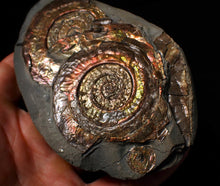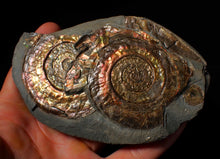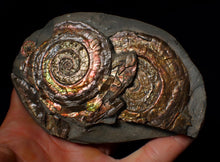
A stunning example of an iridescent ammonite fossil of the species Psiloceras planorbis from North Somerset, UK.
The matrix measures 125 mm (4.9 inches) wide and contains two Psiloceras ammonites preserved on top of one another. The ammonites sit in the original limestone matrix in which they were found that has been shaped around them. The ammonites are very well preserved and have been prepared out of the rock to reveal the shells, which display some beautiful multicoloured iridescence with flashes of red, gold, green, and copper that appear as the viewing angle changes.
These fossils are highly sought after and very hard to find, especially complete like this. They are preserved in the same way as the famous Canadian "Ammolite" ammonites that are turned into valuable gemstones. The fossil weighs 160 grams.
Around 200 million years old (Hettangian, Early Jurassic), this fossil would make a wonderful addition to any collection.















